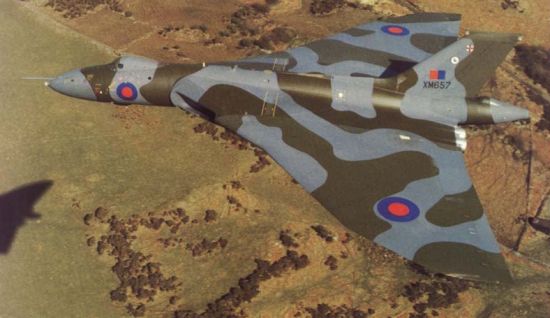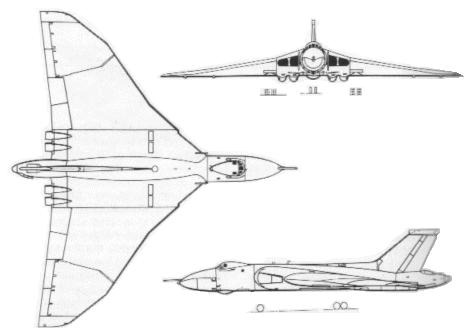|
||||||||||
|
|
||||||||||
|
||||||||||
|
|
||||||||||
 - -
|
|

|
Avro Vulcan Tactical Bomber |
|
DESCRIPTION:
Following World War II, Great Britain realized the importance of maintaining strategic bombers posessing long range, heavy bombloads, high speed, high-altitude performance, and able to be based anywhere in the world. To meet this challenge, Vickers, Avro, and Handley Page were each called upon to develop bombers for the Royal Air Force. These efforts culminated in the V-series of bombers: the Valiant, Vulcan, and Victor. Avro opted for a delta wing design in its model 698, the Vulcan, second of the triad to enter service. Due to the lack of reliable aerodynamic data on delta wings at transonic speeds available at the time, Avro developed the 707 research vehicle to provide design information. Out of this research emerged the Vulcan B.1 with its broad delta wing and circular cross-section fuselage. However, early flight experience with this aircraft revealed that high-g manevers at altitude resulted in heavy buffeting and wing fatigue. The wing was then modified with differing amounts of wing sweep along the semi-span creating the Vulcan's distinctive "kinked delta" shape. The empennage featured a vertical tail, with elevators being integrated into the delta wing, and four engines were placed within the wing root. The fuselage, blended into the wing, provided space for two pilots, three aft-facing crew, and one internal weapons bay for bombs or mines. As the B.1 began entering service as a high-level bomber, Avro began development of an improved B.2 with an enlarged wing, revised control surface arrangement, in-flight refueling capability, and lengthened fuselage. In addition, the new Vulcan model was designed to carry payloads of the Blue Steel stand-off bomb or the Skybolt ballistic missile (carried one under each wing) then under development in the United States. However, the cancellation of Skybolt and the decision to adopt the submarine-launched Polaris missile instead of Blue Steel led to a re-evaluation of the Vulcan B.2. Instead of high-level operations carrying nuclear weapons, the Vulcan was adapted as a low-level conventional bomber carrying general purpose bombs and equipped with an array of advanced electronic countermeasures (ECM). Several B.2s were later modified as reconnaissance platforms being redesignated the SR.2. Both the B.2 and SR.2 remained in service into the 1980s until retired shortly after their service during the Falklands War.
Data below for Vulcan B.2 |
|
| HISTORY: | |
| First Flight |
(prototype) 3 August 1952 (B.1) 4 February 1955 (B.2) 31 August 1957 |
|
Service Entry
|
(B.2) 1960 (SR.2) 1974 |
| CREW: |
five: pilot, co-pilot, electronics officer, navigator, radar operator
|
|
ESTIMATED COST:
|
unknown
|
| AIRFOIL SECTIONS: | |
| Wing Root | unknown |
|
Wing Tip
|
unknown
|
| DIMENSIONS: | |
| Length |
(B.1) 97.08 ft (29.62 m) (B.2) 99.92 ft (30.45 m) |
| Wingspan |
(B.1) 99.00 ft (30.20 m) (B.2) 111.00 ft (33.83 m) |
| Height |
(B.1) 26.50 ft (8.08 m) (B.2) 27.17 ft (8.28 m) |
| Wing Area |
(B.1) 3,554 ft² (330.80 m²) (B.2) 3,964 ft² (368.26 m²) |
|
Canard Area
|
not applicable
|
| WEIGHTS: | |
| Empty | unknown |
| Normal Takeoff | unknown |
| Max Takeoff | (B.2) 250,000 lb (113,400 kg) |
| Fuel Capacity |
internal: 11,100 gal (42,050 L) external: unknown |
|
Max Payload
|
21,000 lb (9,525 kg)
|
| PROPULSION: | |
| Powerplant |
(B.1) four Bristol Siddeley Olympus 101, 102, or 104 turbojets (B.2) four Rolls-Royce Olympus 201 or 301 turbojets |
| Thrust |
(Olympus 101) 44,000 lb (195.7 kN) (Olympus 102) 48,000 lb (213.5 kN) (Olympus 104) 54,000 lb (240.2 kN) (Olympus 301) 80,000 lb (355.9 kN) |
| PERFORMANCE: | |
| Max Level Speed |
at altitude: 645 mph (1,040 km/h), Mach 0.98 at sea level: unknown cruise speed: 625 mph (1,005 km/h), Mach 0.94 |
| Initial Climb Rate | unknown |
| Service Ceiling |
(B.1) 55,000 ft (16,780 m) (B.2) 65,000 ft (19,810 m) |
| Range |
(B.1) 2,605 nm (4,825 km) (B.2) 3,995 nm (7,400 km) |
| g-Limits |
unknown
|
| ARMAMENT: | |
| Gun | none |
| Stations | one internal weapons bay |
| Air-to-Air Missile | none |
| Air-to-Surface Missile | none (GAM-87 Skybolt planned) |
| Bomb | up to 21 1,000 lb (454 kg) GP |
| Other |
mines
|
| KNOWN VARIANTS: | |
| B.1 | Original production model |
| B.1A | Conversion applied to all Vulcan B.1 airframes in service involving addition of an updated tailcone housing electronic countermeasures (ECM) equipment |
| B.2 | Enlarged model with increased wingspan and wing area, more powerful engines, elevons replacing the ailerons and elevators of the B.1, a new APU, in-flight refueling capability, and equipped to carry the Blue Steel bomb or the Skybolt missile; adapted as low-level bomber following cancellation of Blue Steel and Skybolt |
| SR.2 |
B.2 airframes modified as a strategic reconnaissance model
|
|
KNOWN COMBAT RECORD:
|
Falklands War (UK, 1982)
|
|
KNOWN OPERATORS:
|
United Kingdom (Royal Air Force)
|
|
3-VIEW SCHEMATIC:

|
|
SOURCES:
|
|


|
Aircraft | Design | Ask Us | Shop | Search |

|
|
| About Us | Contact Us | Copyright © 1997-2023 | |||
|
|
|||